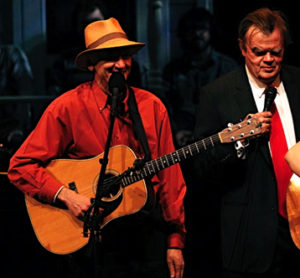Guitar Lessons
I teach bluegrass, fiddle tune lead and backup, and Western Swing lead and rhythm guitar.
Bluegrass, fiddle tune lead and backup: I’ll cover techniques such as correct hand and finger posture, getting good tone and proper use of the pick. Much work is done on getting a correct bluegrass rhythm guitar sound in the styles of pioneers like Jimmy Martin and Tony Rice. Using my own book, Jack Tuttle’s Bluegrass Guitar Primer, we’ll learn standard fiddle tunes and how to take solos over bluegrass singing pieces.
For more advanced students, we’ll learn solos by some of the great players, such as Doc Watson, Clarence White and Tony Rice. Tablature is used, but also learning by ear is encouraged. Developing improvising skills is also a major focus for those who are ready and willing. Also available to work out of is me second guitar book, Jack Tuttle’s Bluegrass Guitar Collection.
Swing and Western Swing rhythm and lead guitar: I teach old style jazz, known commonly as Swing, in addition to the Texas flavored Western Swing guitar style. Usually I start students with Western Swing standards and and the “sock” western swing chords. You’ll learn the walking bass style of chordal backup pioneered by Bob Wills’ Eldon Shamblin on songs like “Take Me Back To Tulsa” and “Miss Molly”. We’ll also explore improvising using the CAGED fingerboard system to develop an understanding of soloing in Swing and Western Swing. We can also learn how to accompany Texas Style fiddle tunes, like Grey Eagle and Sally Johnson.
Students are encouraged to record the lesson.
Here are some helpful resources for guitar:
- I have two bluegrass guitar books with some mp3s at my shop.
- View my Recommended Guitar Albums and Recommended Bluegrass Albums on the About Bluegrass page.
- View the transcriptions below for a few tunes to work on.
- Go to the About Bluegrass Page for tips on fitting into a bluegrass band.
My list of practice suggestions has always included playing with others. Strum Machine is a great online tool for playing along with that can help you get there. It can also be a good “non-complaining” accompanist for when you want to go through your fiddle tunes for hours on end. It can also be your metronome as you try to play slow cleanly, or get faster. It’s also great for improvising over chord progressions.
Transcriptions:
- Guitar Pick Exercises
- Fireball Mail audio file from my CBA “putting the blue in bluegrass” workshop
- Bury Me Beneath the Willow audio file from my CBA “putting the blue in bluegrass” workshop
- Clinch Mountain Backstep – my arrangement from my guitar book
- Old Joe Clark – beginner arrangement from my guitar book
- Whiskey Before Breakfast – my arrangement
- Whiskey Before Breakfast – as played by Molly Tuttle
- Gold Rush – my arrangement
- Foggy Mountain Top – my arrangement
- Highway of Regret – by James Allen Shelton
- Tablature Paper – for writing out your own tab
- Rebecca – I added this to the latest version of my book
- Blackberry Blossom – also from my book
- End Runs in G I-V-I
- End Runs in G V-V-I
- Endings
- Swing Chords
- Cluck Old Hen
Exploring the Fingerboard for Bluegrass Guitar
- Soldier’s Joy – E position
- Blue Ridge Cabin Home – E position
- Arkansas Traveler – C position
- Why Did You Wander? – C position
Molly and Jack Tuttle on A Prairie Home Companion in October 2012.



